

 |
Search the Site with

|
| Sorry, no coat of arms available. | 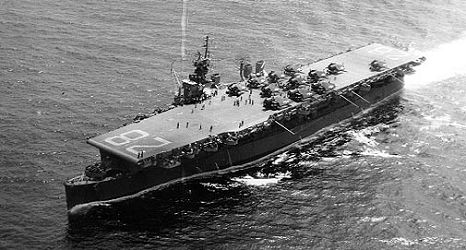 |
USS CABOT was one of the INDEPENDENCE - class light aircraft carriers and the second ship in the Navy named after John Cabot (1450-1498), the Venetian navigator who discovered the North American continent in 1497 while sailing under the sponsorship of King Henry VII of England. Like the other ships in her class, the CABOT was originally laid down as a light cruiser but following the attack on Pearl Harbor, Hi., the Navy had an urgent need for more aircraft carriers. Therefore, a few of the light cruisers under construction at that time were reordered as aircraft carriers.
Decommissioned on February 11, 1947, the CABOT was recommissioned in October 1948 and served as training carrier until decommissioned again in January 1955. In 1967, the carrier was loaned to the Spanish Navy and recommissioned as DEDALO. Stricken in 1989, the old carrier was given to a private organization in the US for use as a museum ship. These plans, however, did not become true and the CABOT/DEDALO was scrapped in 2000.
| General Characteristics: | Awarded: 1940 (as light cruiser), 1942 (as aircraft carrier) |
| Keel laid: June 2, 1942 | |
| Launched: April 4, 1943 | |
| Commissioned: July 24, 1943 | |
| Decommissioned: February 11, 1947 | |
| Recommissioned: October 27, 1948 | |
| Decommissioned: January 21, 1955 | |
| Builder: New York Shipbuilding, Camden, N.J. | |
| Propulsion system: geared turbines, 100,000 shp | |
| Propellers: two | |
| Length: 623 feet (189.9 meters) | |
| Beam: 71.5 feet (21.8 meters) | |
| Draft: 25.9 feet (7.9 meters) | |
| Displacement: approx. 11,000 tons standard | |
| Speed: 31.5 knots | |
| Aircraft: 34 | |
| Catapults: two | |
| Aircraft Elevators: two | |
| Armament: 26 x 40mm guns, 5 x 20mm guns | |
| Crew: approx. 1560 |
Crew List:
This section contains the names of sailors who served aboard USS CABOT. It is no official listing but contains the names of sailors who submitted their information.
USS CABOT Cruise Books:
USS CABOT History:
USS CABOT was laid down as WILMINGTON (CL 79), redesignated CV 28 on 2 June 1942, renamed CABOT 23 June 1942, converted while building, and launched 4 April 1943 by New York Shipbuilding Co., Camden, N.J.; sponsored by Mrs. A. C. Read; re-classified CVL 28 on 15 July 1943; and commissioned 24 July 1943, Captain M. F. Shoeffel in command.
CABOT sailed from Quonset Point, R.I., 8 November 1943 for Pearl Harbor, where she arrived 2 December. Clearing for Majuro 15 January 1944, she joined TF 58 to begin the consistently high quality of war service which was to win her a Presidential Unit Citation. From 4 February to 4 March 1944 she launched her planes in strikes on Roi, Namur, and the island stronghold of Truk, aiding in the neutralization of these Japanese bases as her part in the invasion of the Marshalls.
CABOT returned to Pearl Harbor for a brief repair period, but was back in action from Majuro for the pounding raids on the Palaus, Yap, Ulithi, and Woleai at the close of March 1944. She sailed to provide valuable air cover for the Hollandia operation from 22 to 25 April, and 4 days later began to hurl her air power at Truk, Satawan, and Ponape. She cleared Majuro again 6 June for the preinvasion air strikes in the Marianas, and on 19 and 20 June launched sorties in the key Battle of the Philippine Sea, the famous "Marianas Turkey Shoot," which hopelessly crippled Japanese naval aviation. CABOT's air units pounded Japanese bases on Iwo Jima, Pagan, Rota, Guam, Yap and Ulithi as the carrier continued her support of the Marianas operation until 9 August.
Preinvasion strikes in the Palaus in September 1944 along with air attacks on Mindanao, the Visayas, and Luzon paved the way for the long-awaited return to the Philippines. On 6 October CABOT sailed from Ulithi for raids on Okinawa, and to provide air cover for her task group during the heavy enemy attacks off Formosa on 12 and 13 October. CABOT joined the group which screened "Cripple Division 1," the cruisers CANBERRA (CA 70) and HOUSTON (CL 81) which had been torpedoed off Formosa, to the safety of the Carolines, then rejoined her group for continued air strikes on the Visayas, and the Battle for Leyte Gulf on 25 and 26 October.
CABOT remained on patrol off Luzon, conducting strikes in support of operations ashore, and repelling desperate suicide attacks. On 25 November a particularly vicious one occurred. CABOT had fought off several kamikazes when one, already flaming from hits, crashed the flight deck on the port side, destroying the still-firing 20 mm gun platform, disabling the 40 mm mounts and a gun director. Another of CABOT's victims crashed close aboard and showered the port side with shrapnel and burning debris. Cabot lost 62 men killed and wounded, but careful training had produced a crew which handled damage control smoothly and coolly. While she continued to maintain her station in formation and operate effectively, temporary repairs were made. On 28 November she arrived at Ulithi for permanent repairs.
CABOT returned to action 11 December 1944, steaming with the force striking Luzon, Formosa, Indo-China, Hong Kong, and the Nansei Shoto in support of the Luzon operations. From 10 February to 1 March 1945, her planes pounded the Japanese homeland and the Bonins to suppress opposition to the invasion of Iwo Jima. Continued strikes against Kyushu and Okinawa in March prepared for the invasion of the latter island. After these prolonged, intensive operations, CABOT was homeward bound for San Francisco for a much-needed overhaul completed in June.
After refresher training at Pearl Harbor, the carrier launched strikes on Wake Island on 1 August while en route to Eniwetok. Here she remained on training duty until the end of the war. Sailing 21 August, she joined TG 38.3 to support the landings of occupation troops in the Yellow Sea area in September and October. Embarking homeward-bound men at Guam, CABOT arrived at San Diego 9 November, then sailed for the east coast. CABOT was placed out of commission in reserve at Philadelphia 11 February 1947.
Recommissioned 27 October 1948, CABOT was assigned to the Naval Air Reserve training program. She operated out of Pensacola, then Quonset Point, on cruises to the Caribbean, and had one tour of duty in European waters from 9 January to 26 March 1952. CABOT was again placed out of commission in reserve 21 January 1955. She was reclassified AVT 3 on 15 May 1959.
In 1967, after over twelve years in "mothballs", CABOT was loaned to Spain, in whose navy she served as DEDALO. The loan was converted to a sale in 1972. DEDALO was stricken by the Spanish Navy in August 1989 and given to a private organization in the US for use as a museum ship. However, during the subsequent decade plans to memorialize CABOT/DEDALO met with no success, and the now much deteriorated ship was sold for scrapping in 1997. After the failure of a lengthy legal effort to preserve the old carrier, she was cut up at Brownsville, Texas, beginning in November 2000.
Inaddition to the Presidential Unit Citation, CABOT received nine battle stars for World War II service.
USS CABOT Image Gallery:
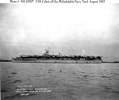 | 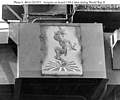 | 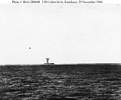 | 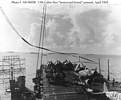 |
 Back to Light Aircraft Carriers list.
Back to Light Aircraft Carriers list.  Back to Ships list.
Back to Ships list.  Back to selection page.
Back to selection page.  Back to 1st page.
Back to 1st page.